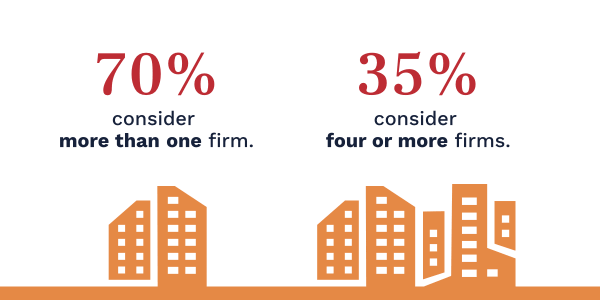Talent remains the No. 1 challenge for law firm leaders, according to a June report from Thomson Reuters.
The current talent fracas notwithstanding, the fight for quality laterals has always been a heated one. Throughout the last decade, about 2,750 laterals moved about the AmLaw 200 each year, with an average book of business of $2 million.
Indeed, according to analysis by Decipher and ALM Intelligence, lateral partner hires are the “single largest source of revenue growth potential for law firms.”
We know that lateral partners shop around; according to Major, Lindsey & Africa’s 2020 Lateral Partner Satisfaction Survey, 70 percent of laterals considered more than one firm. More than one-third, 35 percent, looked at four or more firms.
How can your website set your firm apart as an employer of choice?
Content
Your site should address the factors lateral candidates say matter most. In the Major, Lindsey & Africa report, the top three priorities were:
- Practice area support
- Firm culture
- Personality of partners
These concerns outranked anticipated compensation, client base and geographic reach, among others.
Keep your laterals in mind with smart tactical presentation:
Practice area support. Do your practice area pages show investment in the subject matter, in terms of bench strength and thought leadership? Do they demonstrate that you are present at the organizations that matter? Beyond a roster of the lawyers, do they provide information on key administrative personnel that help clients and timekeepers?
Most of all, do your practice area pages convey that your firm is a safe and smart place to trust a lateral’s hard-earned book of business?
Firm culture. What is it like to work at your firm? Is it formal, casual, traditional, organized or laissez-faire? This is a subject where “Show, Don’t Tell” matters: Don’t just say you have a great culture, show examples that help potential laterals see themselves working with you.
Share firm traditions – whether elegant or offbeat. Bartimus Frickleton Roberton Rader’s website highlights the firm’s standing “Sandwich Tuesday,” where the team meets to make hundreds of sandwiches for a local shelter. A website visitor can see the managing partner and one of the named partners in the kitchen, with gloves on their hands, assembling sandwiches. The message: We give back to the community – but we expect you to roll up your sleeves, too.
Personality of partners. Simply put, are you jerks? Are the partners at your firm the kind of human beings one wants to spend their days with?
It’s helpful to incorporate some humanity into lawyer bios; this can be done through warm photography, a captivating narrative, and more. But to truly let your partners’ personalities come through, nothing tops video. Nexsen Pruet’s website has a dedicated video center, where partners discuss legal news of note. After the lockdown phase of the pandemic, Nexsen Pruet posted a reassuring message from its managing partner, which explained return-to-office protocols along with video that showed them in action.
It’s worth noting that the personality of your partnership is of heightened importance to two critical audiences for diverse recruiting. Both women and Black lawyers rated “personality of partners” higher than the total response base.
Format
As you build or update your site, make sure your “Careers” page is not only speaking to law students. Your laterals are a vastly different audience; they merit a specific section that addresses their wants and needs.
You do not need truckloads of content, but acknowledge that lateral lawyers are at a different life stage than your summer clerks. Mayer Brown uses an elegant structure on its Careers page, with breakouts for Experienced Lawyers, Graduates & Law Students, and Business Services.
Candor
Be honest about your firm – about who you are and what you offer. While the website cannot make any warranties about compensation, nor deliver upon them, the website does set the tone for those intangibles that laterals prioritized: practice area support, firm culture, partner personalities. Not every law firm is modern or casual – and not every lateral wants that.
In the Major, Lindsey & Africa lateral survey, fewer than half of respondents rated their current firms as “very candid” in the recruitment process. Nearly 20 percent said their firms were “not candid.” This was especially true for diverse audiences: Hispanic lawyers were more than twice as likely as white lawyers to describe their firms as “not very candid,” while women were 20 percent less likely than men to say their firm was “very candid.”
Your website may be among the first “touches” your law firm has with a prospective lateral. Start the recruiting process with a purposeful approach that introduces your firm, shows your strengths, and accurately presents the working environment. Help these laterals determine the fit from the start – and always remember you can present the firm in its best light without resorting to a dishonest disconnect.

